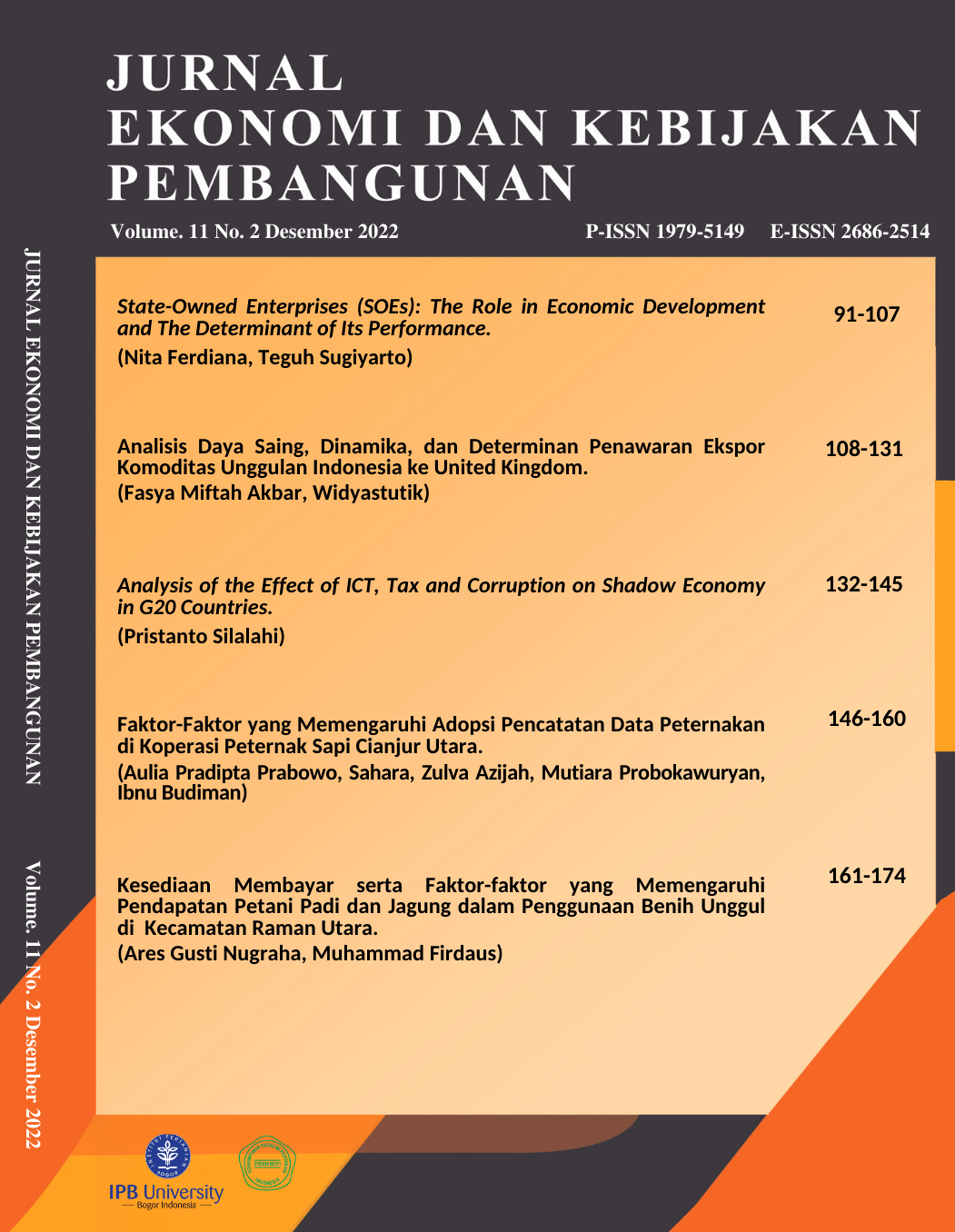Analysis of the Effect of ICT, Tax and Corruption on Shadow Economy in G20 Countries Duta Wacana Christian University
Abstract
The phenomenon of the shadow economy has become a special concern and is quite interesting from many researchers because of its role that is not visible to the naked eye but whose contribution is quite large in the economy. This paper identifies and analyzes the influence factors of the shadow economy for the G20 countries, which are developing economies and developed countries. The average size of the shadow economy as a proportion of GDP in 2010–2018 in developing countries is around 27 percent, while in developed countries it is around 17 percent. The analytical method used in this study is the fixed effect through panel data in the period 2010-2018. This study uses the MIMIC model as a measure of the shadow economy. The results of this study found that the impact of ICT, Control of Corruption, and taxes significantly affect the shadow economy. The interesting thing and the main implication of this empirical study is that the shadow economy does not only occur in EMDE's countries, but also occurs in advanced economies.
References
Bhattacharaya, R. (2019). ITC solutions for the informal sector in developing economies: what can one expect?. Electronic Journal of Information Systems in Developing Countries, 85(3), 1–7.
https://doi.org/10.1002/isd2.12075
Chacaltana. J. Leung. V. & Lee. M. (2018). New technologies and the transition to formality: The trend towards e-formality. ILO Employment Policy Department Working Paper. 247.
Choi. J. & Thum. M. (2005). Corruption and the shadow economy. International Economic Review. 46(3). 817–836. https://doi.org/10.1111/j.1468-2354.2005.00347.x
Dreher. A. Kotsogiannis. C. & McCorriston. S. (2008. forthcoming). How do institutions affect corruption and the shadow economy? International Tax and Public Finance.
Dreher. A. & Schneider. F. (2010). Corruption and the shadow economy: an empirical analysis. Public Choice. 144 (1). 215-238.
Ekananda, M. (2016). Analisis Ekonometrika Data Panel. Jakarta: Mitra Wacana Media.
Friedman, E., S. Johnson, D. Kaufmann, and P. Zoido-Lobatón. (2000). Dodging the Grabbing Hand: The Determinants of Unofficial Activity in 69 Countries. Journal of Public Economics. 76 (3). 459-493. https://doi.org/10.1016/S0047-2727(99)00093-6
Garcia-Murillo. M. & Velez-Ospina. JA (2017). ICTs and the informal economy: mobile and broadband roles. Digital Policy. Regulation and Governance.
Goel, RK, & Nelson, MA (2016). Shining a light on the shadows: Identifying robust determinants of the shadow economy. Economic Modeling. 58(C), 351–364. https://doi.org/10.1016/j.econmod.2016.06.009
Hibbs. D.A. Jr. & Piculescu. V. (2005). Institutions. corruption and tax evasion in the unofficial economy. Gothenburg. Department of Economics.
Johnson, Simon, Kaufmann, Daniel, and Andrei Shleifer (1997). “The unofficial economy in transition.” Brookings Papers on Economic Activity, Fall, Washington DC
Kelmanson , MB, Kirabaeva , K., Medina, L., Mircheva , M., & Weiss, J. (2019). Explaining the shadow economy in Europe: size, causes and policy options. International Monetary Fund.
Mara, ER (2021). Drivers of the shadow economy in European Union welfare states A panel data analysis. Economic Analysis and Policy. 72, 309-325. https://doi.org/10.1016/j.eap.2021.09.004
Medina, L., & Schneider, MF (2018). Shadow economies around the world: what did we learn over the last 20 years? International Monetary Fund.
Nevzorova. E.N. Kireenko. A. P. & Leontyeva. YV (2018. October). If Development of Technologies can Win Shadow Economy. In 2018 XIV International Scientific-Technical Conference on Actual Problems of Electronics Instrument Engineering (APEIE) (pp. 422-428). IEEE.
Orsi, R., Raggi, D., & Turino, F. (2014). Size, Trend, and Policy Implications of Underground Economy. Review of Economic Dynamics. 17(3), 417-436. https://doi.org/10.1016/j.red.2013.11.001
Remeikienė. R. Gasparėnienė. L. Pay. Y. Ginevičius. R. & Ragaišytė. IM (2022). ICT development shadow economy: Empirical evidence from the EU transition economies. Economic Research- Ekonomska Istraživanja . 35 (1). 762-777.
Saputra, AH, & Nugroho, R. (2016). Determining Factors Quantity Shadow Economy in Brics Countries and Indonesia. Info Artha, 1, 29-38. https://doi.org/10.31092/jia.v1i1.68
Schneider. F. & Buehn. A. (2016). Estimating the Size of the Shadow Economy: Methods. Problems and Open Questions. IZA Discussion Paper.
Schneider. F. & Enste. DH (2000). Shadow Economies: Size. Causes. and Consequences. Journal of Economic Literature. 38 (1). pp 77-114. https://doi.org/10.1257/jel.38.1.77
Schneider, F. (2010). The influence of public institutions on the shadow economy: An empirical investigation for OECD countries. Review of Law & Economics. 6 (3). 441-468. https://doi.org/10.2202/1555-5879.1542
Schneider, F. (2012). The shadow economy and work in the shadow: what do we (not) know?
Smith, P. (1994). Assessing the size of the underground economy: the statistics canada perspective. Statistics Canada, National Accounts & Environment Division.
Toggler. B. (2006). The importance of faith: tax morale and religiosity. Journal of Economic Behavior and Organization. 61 (1). 81–109. https://doi.org/10.1016/j.jebo.2004.10.007
Toggler. B. & Schneider. F. (2009). The Impact of Tax Morale and Institutional Quality on the Shadow Economy. Journal of Economic Psychology. 30 (2). 228-245. https://doi.org/10.1016/j.joep.2008.08.004
Williams, CC, & Schneider, F. (2016). Measuring the Global Shadow Economy: the prevalence of informal work and labor. Edward Elgar Publishing.
Zhanabekov, S. (2022). Robust determinants of the shadow economy. Bulletin of Economic Research.
Authors

This work is licensed under a Creative Commons Attribution-ShareAlike 4.0 International License.
The authors who publis article(s) in Jurnal Ekonomi and Kebijakan Pembangunan have to understand and agree that the copyright of article published is owned by Jurnal ekonomi and Kebijakan pembangunan including to reproduce, distribute and sell this journal to public.

